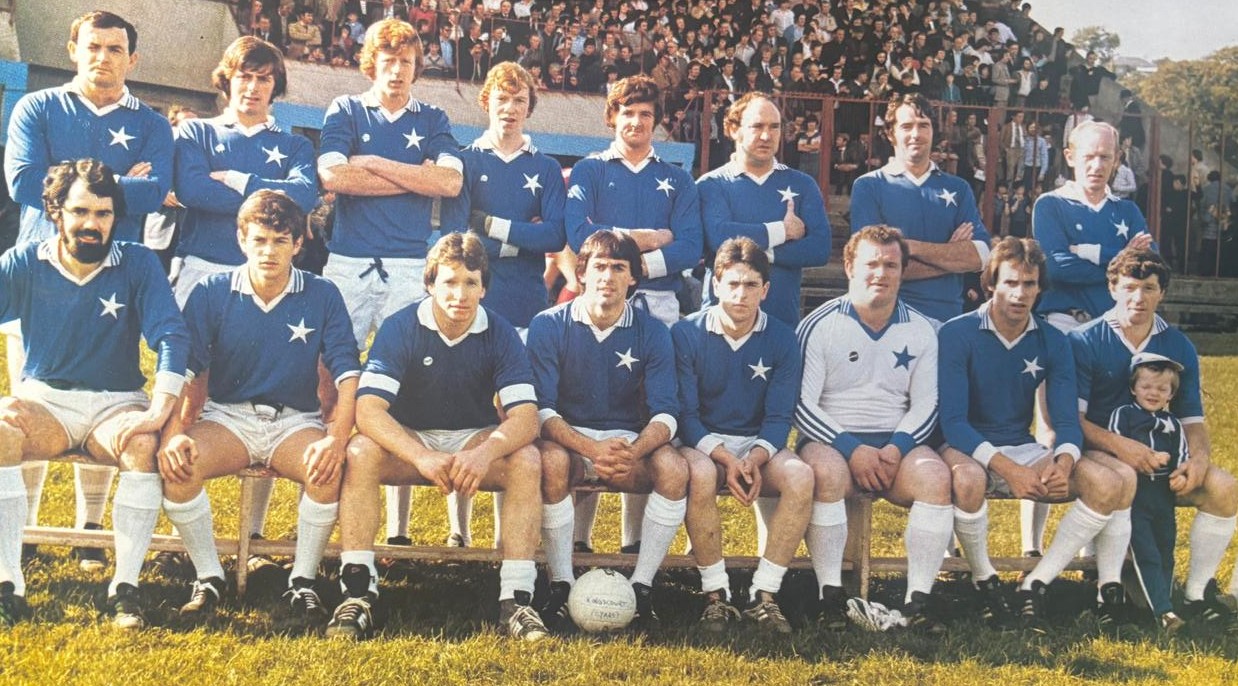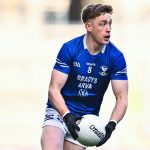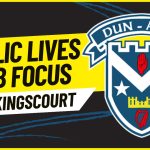When Pat Faulkner won the first of his eight Cavan senior medals in 1980, Kingscourt had just one county title to their name. It was start of their golden era. He spoke to Michael McMullan
THINK of Kingscourt Stars and you get a picture of their history. A distinctive star on their jersey and the players who pulled on the Breffni blue.
Tucked on the shoulders of Cavan and Monaghan, they are level on 11 titles with champions Crosserlough. Mullahoran have one more. Cavan Gaels have 14. Cornafean’s 20 tops everyone.
Before their golden spell in the eighties, their 1921 senior success stood alone. There was a 1955 final defeat. An intermediate title and two at junior were their lot.
When success came in the eighties, it arrived with a bang. Pat Faulkner was among a core of u-21 players breaking in from the 1979 winning team.
From the early days of u-12 football, under men like Robbie O’Connell and Peter Connolly, they began to find success.
It was the days when everyone thronged to the football field, only going home when darkness or hunger said so. No phone, no internet, no game consoles. Just football.
“There’d be big wide streets in Kingscourt at the time and so we’d be playing ball up and down all the youngsters,” Faulkner recalls. “We were quite a close-knit group.”
Another important factor was the local employment. While other clubs were losing players to emigration, Kingscourt’s core remained.
The young players grew up together, socialised together and their tight bond helped when it came to football too.
“There was no tradition there with football but then we had a good young committee at the time,” said Faulkner, who’d later serve four years as chairman.
Back then, Sean Farley was in the chair with Phil Smith serving as secretary. The committee fundraised and the facilities were a testament to the collective effort.
“Anything we ever wanted, they looked after us,” he said. “So, the club was being run well along with the team coming along at the same time.”
Going into the 1980 Cavan Senior Championship, Kingscourt were well down the pecking order, not even in the conversation. A look at The Anglo Celt pen-pics ahead of the final, five of the starting team were aged 21 or younger. The average age was around 22 or 23.
“We had a few older guys that were playing on,” Faulkner said. “Pat Tinnelley would have been captain of Cavan when we won Ulster in ‘67 and ‘69.
“We were looking up to the likes of him and he was a very grounded man and he’d always encourage you and you’d play for the likes of him.”
Johnny Tierney was player-manager. Full-back Johnny Sherlock and corner forward Martin Wakely made up the rest of the old guard.
“No one would have given us a hope, no one would have talked about us at all,’ Falkner said of Kingscourt’s chances.
They were winners over Ramor United in the semi-final, after going five points up early on. It was Crosserlough in the final who had won seven successive titles at the turn of the seventies.
“We were completely unheard of, we would just come out of no place really,” Faulkner added.
Manager Tierney had a firm yet relaxed managerial style, mopping up any pressure.
There was still a confidence despite the underdogs’ tag. With youthful exuberance, the message was about expressing themselves.
The committee pulled out all the stops by raising money to kit the team out in new suits for the final.
“We all landed to Breffni Park these grey slacks and Kingscourt blazers, so we thought we were the bees’ knees,” Faulkner said with a laugh.
“There’s a picture of us all in the blazers, heading off on the bus to the game.”
For all their play, Kingscourt needed goalkeeper Francis McKenna to turn a Gene Cusack flick away from the net and breathed a sigh of relief when a late sideline ball dropped short as Crosserlough came in search of an equalising point. Kingscourt had done it. The famine was over.
There was a parade by the Kingscourt local brass and reed band back into the town. The players were up on the back of a lorry to signal the start of the celebrations.
The cup was brought around the four schools in the parish in the days after. Homework was parked.
“It was a great buzz and then the kids got to know who you were,” Faulkner recalls.
“When you were up at the schools, all the kids wanted was to play football after that. It set a benchmark.”
Numbers climbed at league games. The scenes of being surrounded by family and friends after the final painted a picture of success. And everyone wanted their slice.
It took a replay to see off Drumalee in the final the following year before three years in the dark with exits to Laragh United, who completed three-in-a-row, an amalgamation team Sillan Gaels and Ramor United. Kingscourt were back in the final in 1985 but lost heavily to Ramor.
“We probably got a bit complacent, I’d say, at that stage until we regrouped,” Faulkner said of their disappointing spell before another surge to win the 1986 and ’87 titles.
“A few newer players came through the scene then. The likes of Pat Tinnelly had retired, and he was a big influence on a whole lot of us.”
Other teams upped their games with the sight of the Kingscourt jersey, coupled by a dip in their own performance.
The 1986 final against Ballinagh was their most convincing win before coming back to retain the title the following season.
“Ramor were a very good team that time and they used to test us more often than anyone,” Faulkner said of the landscape. “They won two championships in that space but they probably were unfortunate to meet Kingscourt at their peak.”
Mullahoran, Laragh and Crosserlough were always in the mix with Gowna and Cavan Gaels coming to later to have their time at the top. Kingscourt were the consistent champion.
Eight titles in 14 seasons from 1980 until they squeezed out the ’93 championship says it all.
“We had the same core of players,” Faulkner said of the key men. Alongside his brother Michael, Jim Reilly, Joe Dillon and Barry McCardle, there was a handful of Kingscourt men on the Cavan team. They are also the five with eight county senior medals.
Others followed in later years with a supply of players with county minor and u-21 experience.
After Johnny Tierney and Robbie O’Connell’s spells as manager, Roscommon man Eamon Curley, living in Bailieborough at the time, took over.
“It was probably just the wee lift that we needed after winning nothing from ‘81 to ‘86.
“Eamon came in and Paddy Clarke, from Louth, he came in as well and done a few training sessions. It brought the thing up to another wee level.”
******
For all their success in Cavan, the 1987 Ulster final defeat against Burren is the one that sticks in their throat.
They would lose to Derry’s Lavey three years later, a convincing defeat. Both teams went on to win the All-Ireland but ’87 is the one that got away.
“That was the one we all just regret. It was played in Ballybay, and it spilled rain the whole day, it was a rotten day, wind and rain,’ Faulker recalls. The memory of defeat often lingers longer.
“I know it was low scoring, but the conditions were horrendous. Burren had (John) ‘Shorty’ Trainor, the McGoverns, Paddy O’Rourke, (Tony) McArdle, the Murdocks,” he added.
“They were all playing inter-county football with Down and it was definitely one that we had a chance of winning, but we blew it.
“I’m not saying we’d have gone on and won an All-Ireland. Lavey beat us then, comprehensively in the final then 1990 and that was a good Lavey team.
“Every team that won the county championship, apart from one or two of them, they all were littered with county players.
“Lavey had the Downeys, McGurks, (Brian) McCormick and they were all playing inter-county with Derry.”
Faulkner’s memory also rewinds to 1980 and their first taste of Ulster action against Armagh giants Clan na nGael. Going into the game, they didn’t know what to expect.
There were even the obstacles of getting to Lurgan, enduing the army checkpoints that dominated those years of the Troubles.
“Jim McKerr, Colum McKinstry and Jimmy Smyth, they were all playing for Clan na nGael they were after playing in All-Ireland,” Faulkner said.
“We beat them two years in a row actually, so that would have given us a right lift at the time, that you could go up the north and beat good club teams.”
He recalls the battles with Ballinderry who had Gerry McCusker and Sean McIvor as monsters at midfield. Dungiven had Brian McGilligan in the engine room.
“You were up against top players in these games,” he added.
After the disappointment of losing to Burren in 1987, Kingscourt failed to get out of Cavan the following season before bouncing back to do what they had failed to do in the eighties – win three in a row, 1989, 1990 and 1991.
“That was a big accomplishment at the time,” said Faulkner, who points to the importance of another injection of youth, players like the McCormacks, McCauls and Joe McCarthy.
“They came on the scene then and gave the team a bit of a lift. They were good championships to win and then we probably snuck one at the end, in ‘93 against Gowna.”
It was followed by a 17-year ‘barren spell’ until they won the championship in 2010. Mullahoran beat them after a replay two years later followed by a one-point defeat to Cavan Gaels in 2014.
When title number 11 arrived in 2015, Pat’s son Padraig carried on the tradition as part of the winning formula, before also playing on Cavan’s last Ulster winning team in 2020.
For Faulkner senior, picking through an illustrious career, he rests on two key moments. Winning the first is always special and being part of their three-in-a-row.
“You just put your head down and start a new year, and your aim was to win the county title,” he summed up of a golden generation.
As well as serving as chairman, Pat spent time as senior selector and is never far away from the club’s pulse.
He enjoys watching games now. A nervous father looking in? Apprehensive is a better word.
“He (Padraig) just goes out and does his own thing,” he added, joking how he’d also be his son’s biggest critic.
“As he’d say, when he’d come home, if they won by ten points, I’d always point out the mistake he made.”
Kingscourt play Ballinagh this weekend, hoping to win a third successive game. In Faulkner’s eyes, Crosserlough, Gowna and Ramor are the front-runners.
“We could be dark horses,” he added, while dreaming of getting to a final and, more importantly, winning it.
Below the senior team, the club is healthy. Tyrone native Kevin Shiels is to the fore leading the current committee.
There is an influx of numbers. There are three u-12 teams and two at u-14 level. They’re also catering for ladies football.
Dublin is a one-hour commute in favourable traffic. The local businesses in the locality put their hands in their pocket if they’re asked.
The club is in a healthy state, like the support cast when one title became two, then three and eventually 11.
The men who went before have left strong foundations. Men like Faulkner, from and era when Kingscourt were Kings.
The full interview with Pat is available in the latest edition of our Gaelic Lives podcast
Receive quality journalism wherever you are, on any device. Keep up to date from the comfort of your own home with a digital subscription.
Any time | Any place | Anywhere














